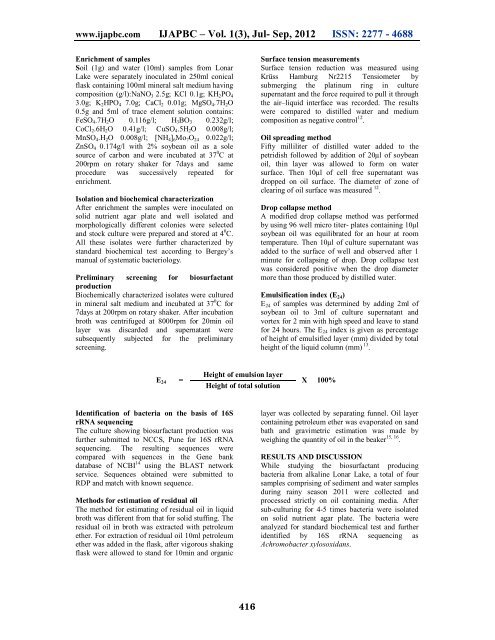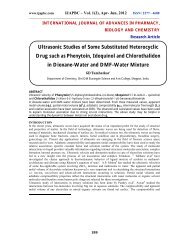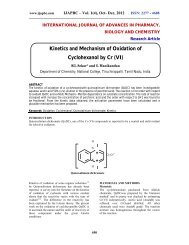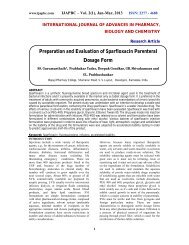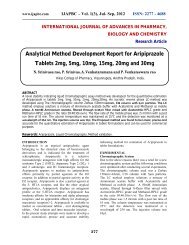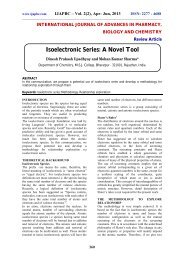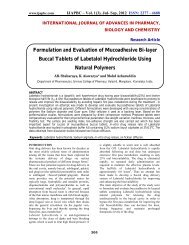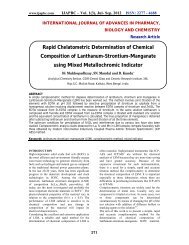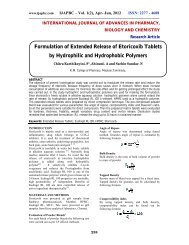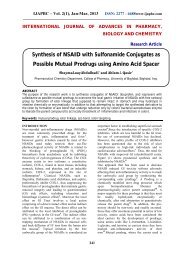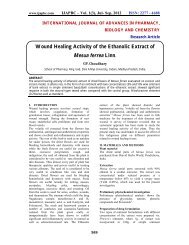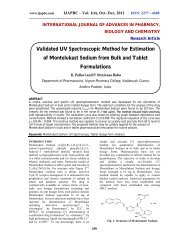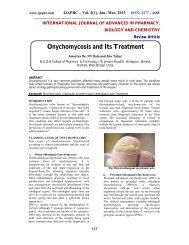Studies on Biosurfactant Production from Lonar Lake's ... - ijapbc
Studies on Biosurfactant Production from Lonar Lake's ... - ijapbc
Studies on Biosurfactant Production from Lonar Lake's ... - ijapbc
You also want an ePaper? Increase the reach of your titles
YUMPU automatically turns print PDFs into web optimized ePapers that Google loves.
www.<strong>ijapbc</strong>.com IJAPBC – Vol. 1(3), Jul- Sep, 2012 ISSN: 2277 - 4688<br />
Enrichment of samples<br />
Soil (1g) and water (10ml) samples <strong>from</strong> L<strong>on</strong>ar<br />
Lake were separately inoculated in 250ml c<strong>on</strong>ical<br />
flask c<strong>on</strong>taining 100ml mineral salt medium having<br />
compositi<strong>on</strong> (g/l):NaNO 3 2.5g; KCl 0.1g; KH 2 PO 4<br />
3.0g; K 2 HPO 4 7.0g; CaCl 2 0.01g; MgSO 4 .7H 2 O<br />
0.5g and 5ml of trace element soluti<strong>on</strong> c<strong>on</strong>tains:<br />
FeSO 4 .7H 2 O 0.116g/l; H 3 BO 3 0.232g/l;<br />
CoCl 2 .6H 2 O 0.41g/l; CuSO 4 .5H 2 O 0.008g/l;<br />
MnSO 4 .H 2 O 0.008g/l; [NH 4 ] 6 Mo 7 O 24 0.022g/l;<br />
ZnSO 4 0.174g/l with 2% soybean oil as a sole<br />
source of carb<strong>on</strong> and were incubated at 37 0 C at<br />
200rpm <strong>on</strong> rotary shaker for 7days and same<br />
procedure was successively repeated for<br />
enrichment.<br />
Isolati<strong>on</strong> and biochemical characterizati<strong>on</strong><br />
After enrichment the samples were inoculated <strong>on</strong><br />
solid nutrient agar plate and well isolated and<br />
morphologically different col<strong>on</strong>ies were selected<br />
and stock culture were prepared and stored at 4 0 C.<br />
All these isolates were further characterized by<br />
standard biochemical test according to Bergey’s<br />
manual of systematic bacteriology.<br />
Preliminary screening for biosurfactant<br />
producti<strong>on</strong><br />
Biochemically characterized isolates were cultured<br />
in mineral salt medium and incubated at 37 0 C for<br />
7days at 200rpm <strong>on</strong> rotary shaker. After incubati<strong>on</strong><br />
broth was centrifuged at 8000rpm for 20min oil<br />
layer was discarded and supernatant were<br />
subsequently subjected for the preliminary<br />
screening.<br />
Surface tensi<strong>on</strong> measurements<br />
Surface tensi<strong>on</strong> reducti<strong>on</strong> was measured using<br />
Krüss Hamburg Nr2215 Tensiometer by<br />
submerging the platinum ring in culture<br />
supernatant and the force required to pull it through<br />
the air–liquid interface was recorded. The results<br />
were compared to distilled water and medium<br />
compositi<strong>on</strong> as negative c<strong>on</strong>trol 12 .<br />
Oil spreading method<br />
Fifty milliliter of distilled water added to the<br />
petridish followed by additi<strong>on</strong> of 20µl of soybean<br />
oil, thin layer was allowed to form <strong>on</strong> water<br />
surface. Then 10µl of cell free supernatant was<br />
dropped <strong>on</strong> oil surface. The diameter of z<strong>on</strong>e of<br />
clearing of oil surface was measured 12 .<br />
Drop collapse method<br />
A modified drop collapse method was performed<br />
by using 96 well micro titer- plates c<strong>on</strong>taining 10µl<br />
soybean oil was equilibrated for an hour at room<br />
temperature. Then 10µl of culture supernatant was<br />
added to the surface of well and observed after 1<br />
minute for collapsing of drop. Drop collapse test<br />
was c<strong>on</strong>sidered positive when the drop diameter<br />
more than those produced by distilled water.<br />
Emulsificati<strong>on</strong> index (E 24 )<br />
E 24 of samples was determined by adding 2ml of<br />
soybean oil to 3ml of culture supernatant and<br />
vortex for 2 min with high speed and leave to stand<br />
for 24 hours. The E 24 index is given as percentage<br />
of height of emulsified layer (mm) divided by total<br />
height of the liquid column (mm) 13 .<br />
E 24 =<br />
Height of emulsi<strong>on</strong> layer<br />
Height of total soluti<strong>on</strong><br />
X 100%<br />
Identificati<strong>on</strong> of bacteria <strong>on</strong> the basis of 16S<br />
rRNA sequencing<br />
The culture showing biosurfactant producti<strong>on</strong> was<br />
further submitted to NCCS, Pune for 16S rRNA<br />
sequencing. The resulting sequences were<br />
compared with sequences in the Gene bank<br />
database of NCBI 14 using the BLAST network<br />
service. Sequences obtained were submitted to<br />
RDP and match with known sequence.<br />
Methods for estimati<strong>on</strong> of residual oil<br />
The method for estimating of residual oil in liquid<br />
broth was different <strong>from</strong> that for solid stuffing. The<br />
residual oil in broth was extracted with petroleum<br />
ether. For extracti<strong>on</strong> of residual oil 10ml petroleum<br />
ether was added in the flask, after vigorous shaking<br />
flask were allowed to stand for 10min and organic<br />
layer was collected by separating funnel. Oil layer<br />
c<strong>on</strong>taining petroleum ether was evaporated <strong>on</strong> sand<br />
bath and gravimetric estimati<strong>on</strong> was made by<br />
weighing the quantity of oil in the beaker 15, 16 .<br />
RESULTS AND DISCUSSION<br />
While studying the biosurfactant producing<br />
bacteria <strong>from</strong> alkaline L<strong>on</strong>ar Lake, a total of four<br />
samples comprising of sediment and water samples<br />
during rainy seas<strong>on</strong> 2011 were collected and<br />
processed strictly <strong>on</strong> oil c<strong>on</strong>taining media. After<br />
sub-culturing for 4-5 times bacteria were isolated<br />
<strong>on</strong> solid nutrient agar plate. The bacteria were<br />
analyzed for standard biochemical test and further<br />
identified by 16S rRNA sequencing as<br />
Achromobacter xylosoxidans.<br />
416


